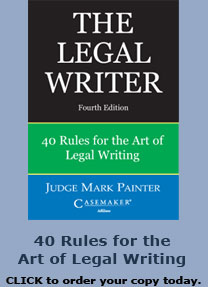Another Victory For Good Writing
By Judge Mark P. Painter
|
Joining Alaska, Delaware, Georgia, Kentucky, Nevada, Michigan, Texas, and Wisconsin, the Indiana Supreme Court has converted to the system of putting all citations in footnotes. These states are the ones where the highest court has converted. In many other states, some appellate judges are doing it right but haven’t yet converted the highest court. For example, that’s the situation in Ohio, where many appellate judges have converted, but the supreme court is still stuck in the past. Having a jumble of letters and numbers in the middle of paragraphs destroys readability. I’ve probably harped on this enough – it is Rule 13 in my Legal Writer book, Citations Go in Footnotes. But some judges and lawyers still resist putting citations in footnotes. The most common objection: “I don’t want to have to look down to see the source of the authority.” The answer: You seldom do. Most citations refer to authority no one questions. When the brief or memo is trying to distinguish or argue between competing authorities, those cases must be identified by name and court in the text. But the letters and numbers still go below. Another objection: “Footnotes are distracting – I feel I have to read them because they might explain the text.” Answer: Not a problem. When citations are in footnotes, nothing else can be there. The modern formula forbids “talking” footnotes – if something is important enough, it should be in the text. One reason we used to put citations in the text was that manual typewriters had a hard time with footnotes, and it was easier to type them in the text. But now our word processors have a footnote key, and it’s easy to drop your citations to the foot of the page. (The old typewriters also accounted for two other mistakes that persist today: (1) underlining cites, because there were no italics – underlining is a signal to the printer to italicize; and (2) Courier type, one of the hardest to read, because typewriters required each letter to have the same spacing.) The Indiana Supreme Court is asking for comments on the change. Whether you are in that state or not, please write praising this change to Supreme Court Administrator, 315 State House, Indianapolis, IN 46204. More Progress In March, Christine Gregoire, the new governor of Washington, issued an executive order mandating the use of plain language: “Using Plain Talk principles, the announcements, publications and other documents agencies send to the public will contain clear and concise instructions and information. Documents written in Plain Talk will include: Clear language that is commonly used by the intended audience:
Though the serial comma is missing from the first sentence, the order makes sense. One other anomaly is that part of the order is couched in legalese, as in “Now, therefore, I, Christine O. Gregoire. . .” and “In witness whereof, I have hereunto set my hand and caused the seal.” But we take heart from any plain-language victories, one step at a time. Dumbing Down? At a recent seminar, one participant asked if the plain-language techniques – short sentences, active voice, no legalese – wasn’t “dumbing down” language. No, it is just uncluttering it. Why make it more difficult than necessary? Legal writing is not always going to be perfectly understandable to the non-law-trained reader. But it should be easily readable for lawyers and judges, and many times for laypeople. Remember that much of our writing – letters to clients, contracts, notices, product warnings – is directed to laypeople. It is not “dumbing down” to make it understandable for the target audience – it may be legally necessary. And John Grisham and Tom Clancy do well writing at the seventh-grade level. Readability In each column, I list the two major readability statistics – remember that you can program Word to tell you these and more. Statistics for this column: 15 words per sentence, 6 percent passive voice. (Remember the 1818 Rule – no more than an average of 18 words per sentence and 18 percent passive-voice sentences.) |
____________________________________
Mark Painter has served as a judge on the Ohio First District Court of Appeals for 10 years, after 13 years on the Hamilton County Municipal Court. He has served as an Adjunct Professor at the University of Cincinnati College of Law since 1990. Judge Painter is the author of five books, including The Legal Writer: 40 Rules for the Art of Legal Writing. The book is available from http://books.lawyersweekly.com. Judge Painter has given dozens of seminars on legal writing, and will give his six-hour legal writing seminar on June 16 in Louisville, Ky. and June 17 in Lexington, Ky. Contact him through his website www.judgepainter.org.








